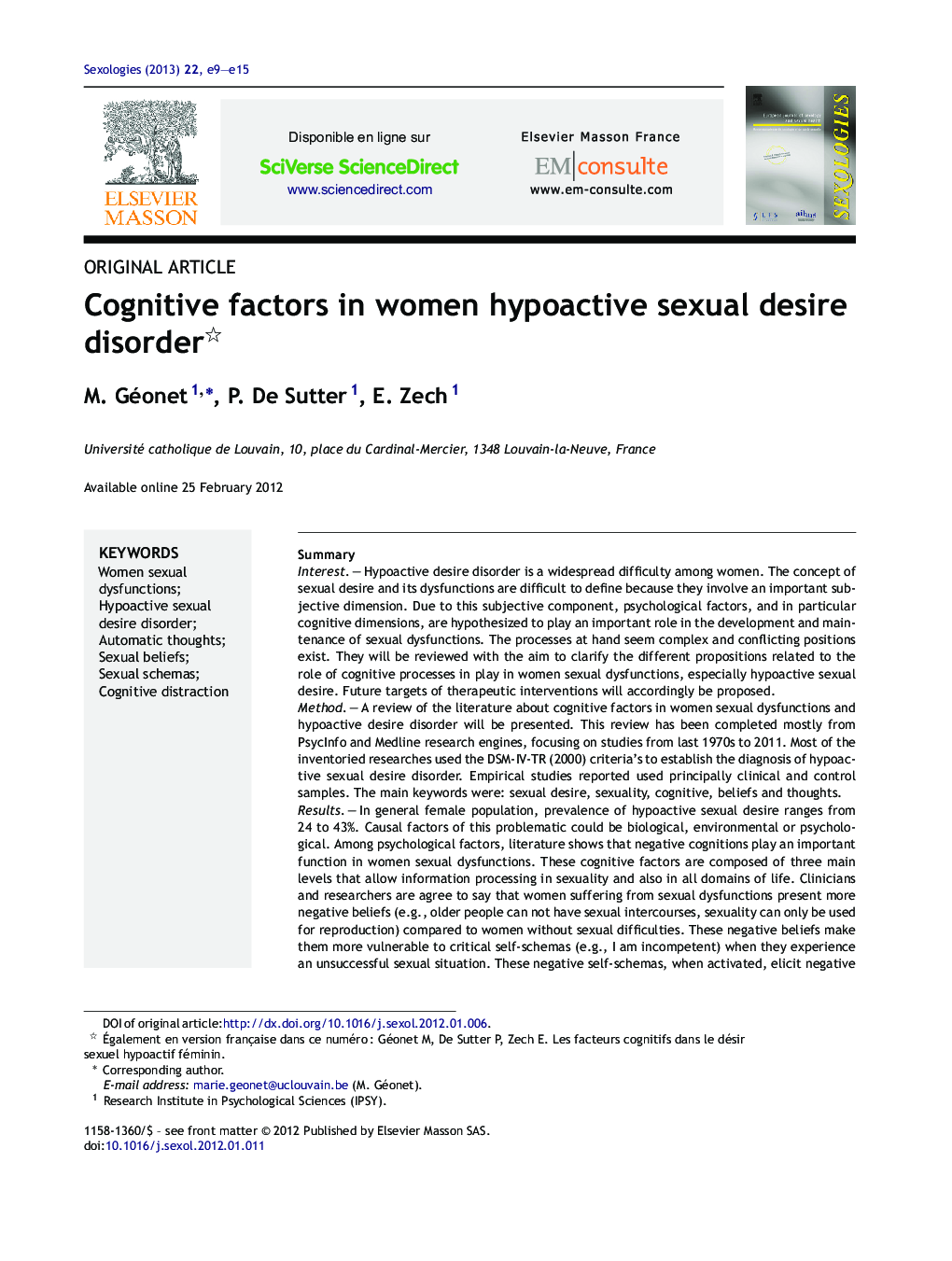| کد مقاله | کد نشریه | سال انتشار | مقاله انگلیسی | نسخه تمام متن |
|---|---|---|---|---|
| 342812 | 548874 | 2013 | 7 صفحه PDF | دانلود رایگان |

SummaryInterestHypoactive desire disorder is a widespread difficulty among women. The concept of sexual desire and its dysfunctions are difficult to define because they involve an important subjective dimension. Due to this subjective component, psychological factors, and in particular cognitive dimensions, are hypothesized to play an important role in the development and maintenance of sexual dysfunctions. The processes at hand seem complex and conflicting positions exist. They will be reviewed with the aim to clarify the different propositions related to the role of cognitive processes in play in women sexual dysfunctions, especially hypoactive sexual desire. Future targets of therapeutic interventions will accordingly be proposed.MethodA review of the literature about cognitive factors in women sexual dysfunctions and hypoactive desire disorder will be presented. This review has been completed mostly from PsycInfo and Medline research engines, focusing on studies from last 1970s to 2011. Most of the inventoried researches used the DSM-IV-TR (2000) criteria's to establish the diagnosis of hypoactive sexual desire disorder. Empirical studies reported used principally clinical and control samples. The main keywords were: sexual desire, sexuality, cognitive, beliefs and thoughts.ResultsIn general female population, prevalence of hypoactive sexual desire ranges from 24 to 43%. Causal factors of this problematic could be biological, environmental or psychological. Among psychological factors, literature shows that negative cognitions play an important function in women sexual dysfunctions. These cognitive factors are composed of three main levels that allow information processing in sexuality and also in all domains of life. Clinicians and researchers are agree to say that women suffering from sexual dysfunctions present more negative beliefs (e.g., older people can not have sexual intercourses, sexuality can only be used for reproduction) compared to women without sexual difficulties. These negative beliefs make them more vulnerable to critical self-schemas (e.g., I am incompetent) when they experience an unsuccessful sexual situation. These negative self-schemas, when activated, elicit negative automatic thoughts that prevent them from focusing on the erotic context. These negative cognitions can be linked to their own self-image (e.g., “I am not beautiful enough”, “I must be performant”), their partner (e.g., “He is disgusting me”) or linked to the marital relationship (e.g., “He is going to leave me”, “He doesn’t love me anymore”). These negative thoughts trigger emotions like anxiety, shame or guilty. Moreover, these cognitions will have negative impact on sexual response. Indeed, the more negative thoughts will be present; the less will be the subjective sexual arousal. Consequently, during sexual intercourse, women will focus on this thoughts rather than sexual excitements (e.g., kissing, erotic context…). This distraction process is also present in men who concentrate on negative thoughts dealing with sexual performance.ConclusionsFuture empirical studies should investigate the content of sexual beliefs, sexual self-schemas, and automatic thoughts in functional and dysfunctional women. Most studies have used a questionnaire method to explore the cognitive process. This method does not allow to access unconscious processes. To make a reliable evaluation of these processes, methodologies using implicit tasks should be used. With regard to therapeutic interventions addressing psychological/cognitive factors, we propose that automatic negative thoughts, sexual schemas and beliefs should be targeted and worked on using a cognitive restructuring method. A second strategy in the therapeutic intervention could be to address cognitive distraction. A mindfulness training could be used as a tool to implement both: less focus on non erotic thoughts and more attention to sexual stimuli.
Journal: Sexologies - Volume 22, Issue 1, January–March 2013, Pages e9–e15